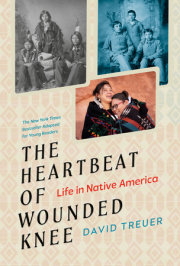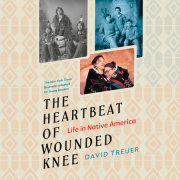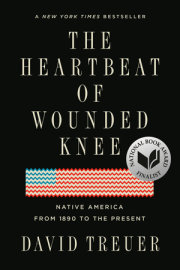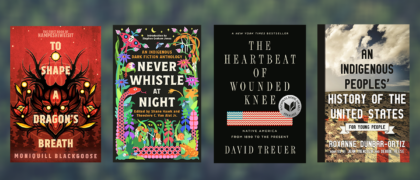Prologue
This book tells the story of what Indians in the United States have been up to in the 130 years since the infamous massacre at Wounded Knee Creek in South Dakota: what we’ve done, what’s happened to us, and what our lives have been like. It is adamantly, unashamedly, about Indian life rather than Indian death. That we even
have lives—that Indians have been living in, have been shaped by, and in turn have shaped the modern world—is news to most people. The usual story told about us—or rather, about “the Indian”—is one of decline and death. Our story begins in unchecked freedom and communion with the earth and ends in confinement and perpetual suffering on reservations. Wounded Knee has come to stand in for much of that history.
But what were the actual circumstances of this event that has taken on so much symbolic weight?
In the 1860s, the U.S. government had been trying to solve the “Indian problem” on the Great Plains with a three-pronged approach: negotiation, starvation, and warfare. Open war on its own had not been going too well. The Plains Indians had won decisive victories and forced the government to the treaty table. In 1868 the Lakota secured a large homeland on the Great Sioux Reservation in southwestern South Dakota and northern Nebraska.
Then gold was discovered in the Black Hills of South Dakota. The Lakota tried to enforce the terms of the 1868 treaty and throw out the gold-seekers who rushed in. Their attempts led, directly, to the Battle of the Little Bighorn, where George Armstrong Custer and the Seventh Cavalry were wiped out on June 25, 1876. During the final hours of the battle, the Lakota and Cheyenne dismounted, put away their guns, and killed the remaining cavalry with their war clubs and tomahawks in a ritual slaughter. Some Dakota women, armed with buffalo jawbones, were given the honor of dispatching the soldiers with a sharp blow behind the ear.
After that defeat, the U.S. government switched tactics. Instead of confronting the Indians head‑on, it encouraged widespread encroachment by settlers, reneged on treaty promises of food and clothing, and funded the wholesale destruction of the once vast buffalo herds of the Plains. By the late 1870s, an estimated five thousand bison were being killed per day.
Without the bison, the Lakota and other Plains tribes could not hope to survive, at least not as they had been surviving. Their reservations might have been designed as prisons, but now they became places of refuge. With the vast buffalo herds gone and a growing white population of ranchers, hunters, railroad workers, prospectors, homesteaders, and soldiers hemming them in, the Plains Indians did what many disenfranchised people have done when threatened on all sides: they turned to God. The Indians, however, turned to God in the form of the Ghost Dance.
The Ghost Dance religion started among the Paiute in Nevada. It promised a payoff: if Indians lived lives of harmony, worked hard, and danced the Ghost Dance, they would find peace on earth and be reunited with the spirits of their ancestors in the afterlife.
As the religion spread from Nevada, it changed. The Lakota believed if they did the Ghost Dance the right way and lived by its rules, they would find peace in this world and the next
and all the white people would be washed away. If Indians returned to their traditional ways of life and forms of religious observance, the natural world would be restored and returned to them.
The Ghost Dance movement brought Indians together in large numbers. This greatly alarmed the U.S. government, which redoubled its ongoing efforts to disrupt Indian lives and break up Indian families. It dismantled the Great Sioux Reservation into five smaller reservations, including Standing Rock and Pine Ridge. The Ghost Dance religion was banned, and government troops near the Pine Ridge Reservation were increased.
Trouble came. In December 1890, Sitting Bull, who had led his people to victories against the U.S. military and who had helped wipe out Custer’s Seventh Cavalry at the Little Bighorn, was arrested on the Standing Rock Reservation. Authorities feared that the famous Hunkpapa Lakota chief would use his considerable influence to promote the Ghost Dance. In a scuffle during the arrest, Sitting Bull was shot and killed by Indian police officers who had been sent in by the reservation’s Indian agent, a white U.S. government official. Hearing this news, Spotted Elk (also known as Chief Big Foot) grew afraid for his life and the life of his Lakota band, which also lived at Standing Rock. Spotted Elk and 350 followers left the reservation. They headed for the sanctuary of Pine Ridge.
En route, Spotted Elk and his band were intercepted by a detachment of the Seventh Cavalry and escorted five miles to a camping spot on Wounded Knee Creek. It was bitterly cold. Before dawn the next day, the rest of the Seventh showed up and set up four rapid-fire cannons around the Indians. The soldiers searched the camp and rounded up thirty-eight weapons. One of the young Lakota men got upset and urged others not to give up their guns so easily; a fight broke out.
What happened next is unclear. Some reported that the Indians opened fire on the government soldiers. Others said that a deaf elder didn’t understand the command to give up his rifle; a soldier grabbed the gun to take it away and it went off. Then five young warriors shrugged off their blankets and exposed concealed rifles. They shot at the soldiers. The soldiers opened fire on the entire camp with their rifles and the cannons. The Indian men put up a desperate resistance but were mowed down. Spotted Elk was killed. The rain of fire from U.S. troops also claimed the lives of many of the soldiers, in one of the deadliest incidents of friendly fire in U.S. military history.
The Lakota women and children took off running down the frozen creek bed. The soldiers mounted their horses, chased them down, and killed them. The fighting lasted an hour, and when it was over, more than 150 Lakota lay dead or dying in the snow. The actual number of dead is still in dispute, with some putting the number at over three hundred. More than half were women and children. A cavalry general toured the scene of the carnage after a three-day blizzard had shrouded the dead in snow. He was shocked by what he saw. “Helpless children and women with babes in their arms had been chased as far as two miles . . . Judging by the slaughter on the battlefield, it was suggested that the soldiers simply went berserk. For who could explain such a merciless disregard for life?”
The massacre at Wounded Knee Creek was covered by more than twenty newspapers. Response to the killings represented something more than sympathy for Indians on the one hand, and bitter and bloody American progress on the other. Rather, both sides saw the massacre as the end not just of the Indians who had died but of “the Indian,” period. The frontier was closed, Indians were confined to reservations. The clash of civilizations seemed to have wound down. The myths and meaning of America had been firmly established. Perhaps this is why the massacre at Wounded Knee became so emblematic. It neatly symbolized the accepted version of reality: an Indian past and an American present and future.
This version of history remained largely unquestioned through World War I, the Great Depression, World War II, and the 1950s. Then came the 1960s: as the fight for civil rights heated up, so did protests against the American involvement in the Vietnam War. Activists grew concerned about the environment and the toxic effects of industrialization and consumerism. Some people questioned whether mainstream culture was the
only culture; interest in a counterculture spread—and the story of “the Indian” surfaced with new intensity in the American consciousness. This awareness was popularized by a highly influential book.
Published in 1970, eighty years after the massacre,
Bury My Heart at Wounded Knee: An Indian History of the American West appeared as news reports of Indian activism were playing out on TV screens across the country, and at a time when many Americans were looking for some other way of being. The book, written by Dee Brown, a white academic librarian, was an enormous success. To date it has sold more than four million copies, and has been published in seventeen languages. It has never gone out of print.
The “greatest concentration of recorded experience and observation” of Indian lives and history, wrote Brown in the opening pages, “came out of the thirty-year span between 1860 and 1890 . . . It was an incredible era of violence, greed, audacity, sentimentality, undirected exuberance, and an almost reverential attitude toward the ideal of personal freedom for those who already had it. During that time the culture and civilization of the American Indian was destroyed.” Beneath Brown’s effort to speak truth to power, however, he relied on and revived the same old sad story of the “dead Indian.” Our history and our continued existence came down to a list of the tragedies we had somehow outlived without really living. As for present-day Native life, Brown wrote only: “If the readers of this book should ever chance to see the poverty, the hopelessness, and the squalor of a modern Indian reservation, they may find it possible to truly understand the reasons why.”
I remember, vividly, reading that passage while in college in 1991, and I was doubly dismayed by Brown’s telling. I was far from home, on a distant coast. I was homesick—for the Minnesota Northwoods, for my Ojibwe reservation, for the only place on earth I truly loved. I was also dismayed because I felt so insignificant in the face of the authority and power with which Brown explained us Indians to the world. He had hundreds of years of history behind him, the most powerful cultural myths of America as evidence, and a command of English I could only dream of. All I had was the small hot point of hope that I mattered, that where I was from mattered, and that someday I would be able to explain—to myself and to others—why.
This book is a counternarrative to the story that has been told about us, but it is something more as well: it is an attempt to confront the ways we Indians ourselves understand our place in the world. We carry within us stories of our origins, and ideas about what our families, clans, and communities mean. But too often we agree with the ways in which we are read by outsiders. Despite how much I missed home and how much I had come to love where I was from, old habits of thought were hard to shake: for too many years I understood my home, the Leech Lake Reservation, only as a place of abject suffering, a “nowhere place” where nothing happened and good ideas went to die. I saw it as
in America but not
of America. I saw myself and my tribe as a ruined people whose greatness lay behind us.
The evidence seemed to be all around me. A brilliant uncle (
the smartest man I ever knew, said my mother) was perpetually stoned, and eventually died of an overdose. Another uncle was shot twice in the chest after firing an arrow through the open window of a police cruiser. A cousin was hit by an RV, and another cousin was so thoroughly shot up by the cops that his body leaked through the unstopped holes when I was asked to shift it in the coffin at his funeral. Our Ojibwe tribal chairman was investigated for robbing our casino at gunpoint. The first Indian elected to the state legislature was convicted of theft and fraud. All this drama and trauma was refracted by the attitudes I heard expressed around me. On a field trip to the state capitol during a protest, my high school band teacher muttered to the class that all Indians were on welfare and we should go back to Canada where we came from. My best friend’s mother told him that I’d gotten into Princeton University and he hadn’t because I was Indian. A high school friend told me that her parents, who owned property in a nearby town, wouldn’t rent to Indians because we were dirty and dangerous. I protested weakly that
I wasn’t dirty,
I wasn’t dangerous.
Oh, well, you’re not really
Indian, she said. To be “really” Indian, evidently, was to be those things.
By the time I graduated from high school, I was ready to leave the reservation and never come back. In my mind, nothing good came from my Indian life. I was tired of the poverty and the dusty roads that no one saw fit to pave. I was sick of the late-night calls and the trips to the hospital to witness the damage we were doing to ourselves. I looked ahead to the green, leafy excellence of Princeton. Nothing was clearer to me than the conviction that my past lay behind me, on the reservation, and the future awaited me beyond our borders, in America. So I left.
As soon as I was gone, I missed it. I missed what I hadn’t known was my Indian life, our collective Indian life. I missed the Mississippi River, which flows through my reservation as a tiny thing, little more than a stream I could walk across. I missed the ways the pine tree scratched the window screens at night. I missed my uncle Davey’s antics, and I missed his love and I missed how he loved me: completely, without judgment, without measure, without censure. I missed the Memorial Day gatherings at the cemetery with my aunt and uncles and cousins, the sandwiches of canned ham mixed with Miracle Whip and relish on white dinner rolls. The yearning for home was rooted in nostalgia, but I was also trying to grow beyond it, toward a place approaching true knowledge.
As kids do when they leave home, I began to see my parents more clearly. I saw how my mother, born into the meanest of circumstances, had gone to nursing school and then to law school and then—quietly, without self-promotion—had returned to the reservation to practice. Indians had been appearing in court for centuries, but for most of my mother’s clients, it was the first time they had shown up with an Indian lawyer by their side, arguing for dignity, for fairness, for justice.
I saw, too, how my father—who was Jewish and had just barely survived the Holocaust—had adopted the Leech Lake Reservation as his home and our causes as his own. I asked him how he had come to feel so comfortable on the reservation.
I was a refugee, I was an outsider. I was told throughout my life I wasn’t enough, I wasn’t good enough, I didn’t belong. When I came here, I felt at home. I felt like people understood me. My father taught high school on our Ojibwe reservation and then worked for the tribe. One summer I picked up a woman I was dating from her aunt’s house on the reservation. She told me her aunt wanted me to say hi to my father for her. Evidently, on Saturday afternoons back in the 1950s, my father would drive to the small village where the aunt lived. He picked up all the Indian kids hanging out there, dropped them off in a larger town where there was more for them to do, then picked them up later when he was done in town and drove them home.
He was the only white man who even thought about us, and went out of his way to give us something to do, something to look forward to, the aunt said.
I started in my own haphazard way to think about our collective Indian past and present, and how the story of it was told. I decided on anthropology as my undergraduate major. In the 1980s and 1990s, anthropology was reckoning with its colonial past and its past practices, especially with regard to Indigenous people around the world. Anthropology was also a great place to have arguments, and for better or worse, I loved having arguments.
Around that time, I also launched my life as a fiction writer. I detested the publishing industry’s pressure to make multicultural fiction engage in cultural show-and-tell. As a result, I wrote novels where the characters never, ever talked about their spirituality or culture; where nary a feather was to be found. Instead, I tried (and often failed) to create complex, fully realized characters. I went on to get my PhD in anthropology, publish a few novels, and write a nonfiction book about reservation life. It was a hybrid like me: part history, part reportage, part memoir.
Through it all, I came to see we Indians often get ourselves wrong. My lack of regard for my own origins and those of my community began to trouble me, and troubles me still. If I could not see myself and my homelands more expansively, more intimately, more deeply than many non-Indians do, then how could I hope that the future of my people would be any different from the story of “the Indian” we’ve always been told and keep telling? Many of us have lived bitter and difficult lives, and we have brought the ghost of our modern afterlife inside ourselves, where it sits judging us, shaping us, putting its fingers over our eyes so that all we can see, all we can feel, is that we were once great people but are great no more, and that we are no longer capable of greatness. We may feel that Dee Brown was right: what we have now is not a civilization, not a culture, not even real selves, but rather a collection of conditions—poverty, squalor, hopelessness—and that these are the conditions in which we live, and the state of our spirit.
This is a narrative that must be laid to rest.
I conceived of a book with a new Indian story, the untold story of the past 130 years. It would reveal the broader and deeper currents of Indian life that have too long been obscured. It would explore the opposite thesis of
Bury My Heart at Wounded Knee: The year 1890 was
not the end of us, our cultures, our civilizations. It was a cruel, low, painful point, yes—maybe even the lowest point since Europeans arrived in the so-called New World—but a low point from which much of modern Indian and American life has emerged.
To tell that story, I embarked on three journeys. I traveled back into our prehistory and up through the early days of colonialism in North America. I also spent the better part of four years traveling the country—Montana, Washington state, New Mexico, Arizona, California, New York, Florida, and everywhere in between. And as I traveled to Indian homelands across the country, researching and writing about our long history, I listened to Indians telling me what they and their people had experienced, what they had done, what their lives meant to them. I did my best to pair their beautiful lives and beautiful struggles with the recorded past, to link them to the chain of cause and effect, action and response, thought and deed, that is our collective living history. Last, I also continued my inward journey, and included it here. I could not in good conscience ask other Indian people to expose themselves in service to my project, to
trust me, if I didn’t take the same risks. I can’t shake the knowledge—and this is perhaps the only place where my anthropological training and my culture actually meet and agree—that it is impossible to separate the teller from the telling. Whatever I say about Indian lives is a way of saying something about myself.
This book is a result of those journeys. As such, it is not a catalog of broken treaties, massacres, and names and dates, of moments when things might have turned out differently. There are, of course, treaties and battles and names and dates. It’s a history book, after all. But it also traces the stories of ordinary Indian people whose lives remind us of the richness and diversity of Indian life today and whose words show us the complexity with which we Indians understand our own past, present, and future. It’s a work of history, but it also includes journalism and reportage, and the deeply personal and deeply felt stories of Indians across the country, mine among them.
This book is written out of the simple, fierce conviction that our Indian cultures are not dead and our civilizations have not been destroyed. It is written with the understanding that our present tense is evolving as rapidly and creatively as everyone else’s.
In a sense, writing this book is a selfish project. I want—I need—to see Indian life as more than a legacy of loss and pain, because I want to pass on to my beautiful children a rich heritage and an embracing vision of who we were and who we are. But I have not created alternative, falsely hopeful realities to make up for a traumatic past or to imagine a better future.
Looking beyond the blinders of the “dead Indian” story means reckoning with relentless attacks on our sovereignty and the suffering that has created. But it also reveals the ingenious and resourceful counterattacks we have mounted over the decades: the resistance to the lives the government would have us live; the many varied paths Indians forged where old ones were closed off or obscured.
This book is about the history we’ve made and the tools with which we’ve made it. Indians are not little ghosts in living color, stippling the landscape of the past and popping up in the present only to warn contemporary Americans to behave (to do better by the environment) or to provide examples of superior spirituality.
To treat the lives lost on that cold South Dakota day in 1890 as merely symbolic is to disrespect those lives. It is also to disrespect the more than two hundred Lakota who survived Wounded Knee and lived on—to experience the pain of loss, yes, but much else as well. They survived to live and grow, to get married and have babies. They survived to hold on to their Lakota ways or to convert to Christianity. They survived to settle on the reservation and, later, to move to cities. They survived to go to school and to college and to work. They survived to make mistakes and recover from them. They survived to make history, to make meaning, to make
life. This book is about them. And it is about the Indians of other communities and tribes around the country, who survived their own holocausts and went on to make their own lives and their own histories, and in so doing, to make and remake the story of America itself.
Copyright © 2022 by Apelles Productions, LLC. All rights reserved. No part of this excerpt may be reproduced or reprinted without permission in writing from the publisher.








